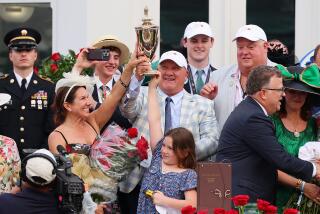At Big Auctions, You Can Make Book on Lukas
- Share via
DEL MAR — Wayne Lukas spent $6.6 million of his clients’ money at the Keeneland Yearling Sales last month. This week he is in Saratoga, where he will spend millions more for well-bred young horses. He is the dominant American buyer at the most important thoroughbred auctions.
Because of Lukas’s immense buying power, many skeptics are unimpressed by his record-breaking achievements as a trainer. Anybody with so many well-bred horses can’t fail to win a lot of races. Yes, Lukas has developed yearling purchases like Winning Colors, Landaluce, Capote, Open Mind and others into champions. But what about all his skeletons in his closet -- the expensive yearlings who never amounted to anything? If you tallied the results of every horse Lukas bought, wouldn’t he be a loser, like most people who buy at yearling auctions?
This question has intrigued many racing fans, and it has preoccupied Joe Bagan, a former social worker in Denver who now is a full-time pedigree buff. Bagan studies thoroughbred breeding ardently and has made occasional stabs at picking yearlings. “We’ve tried every approach to select decent horses and have come up empty,” he said ruefully. So Bagan set out to understand the way Lukas chose horses. He compiled a list of every horse Lukas bought, then traced the horse’s racing record, and found out what the horse was sold for when his racing career was over. Bagan turned the project into a book, “Lukas at Auction,” which he published this year.
And the bottom line is this: Lukas is a winner -- a big winner -- in a game that usually defeats even the most savvy professionals.
From 1979 to 1988, Lukas spent $103 million at horse auctions. Bagan estimates that the training costs for those horses were $22 million -- an outlay of $125 million.
The total proceeds from these horses, plus the residual value of the ones who haven’t raced yet or haven’t been sold, is $162 million. That’s a $37 million profit, an impressive return on any investment.
Although Lukas sets a record every year for purse money won, these earnings are a relatively small part of his income. The big money comes from syndication of stallion prospects and the sale of mares. But by any reckoning Lukas has outshone his competition. Bagan analyzes individual sales and compares Lukas’s performance against his main rivals-Robert Sangster of Great Britain and the Maktoum brothers of Dubai-and Lukas is a clear winner.
Lukas’s critics still may knock his management of individual horses, but his record as a yearling buyer is unimpeachable. He obviously has an extraordinary eye for equine talent.
The trainer likes to use a delightful analogy to explain the way he makes his yearling selections: “In grade-school coloring books they’d show you a farm scene and say, ‘Somewhere in this picture is a cat. Find it.’ You’d look and look and you couldn’t find it. Then finally you see it or somebody points it out to you. Now every time you look at this picture the first thing you see is that cat.”
When Lukas looks at yearlings, he has an image in his mind that leaps out at him -- like the cat in the picture -- when he sees it. “If you train your eye,” he said, “there are certain common threads that run through the good horses.” He won’t divulge his secrets.
Before going to a sale, Lukas will glance through the catalogue in the most cursory fashion. “I couldn’t care less about pedigrees,” he said. He will go to all of the sellers at the auction and have them lead out their yearlings, one by one, and walk them back and forth. In half a minute Lukas will form his opinion and grade the yearling on a scale from 1 to 10. He won’t ask the identity of the yearling until he has made his grade. Then he’ll look at the catalogue and see what kind of pedigree the animal has.
Because Lukas operates at the upper echelon of the racing game he gravitates to the more regal, expensive pedigrees, but occasionally he’ll give a high score to horses with unexceptional bloodlines. At a sale two years ago, he scored a filly 7-plus and then asked his son, Jeff, “What’s this one?”
“She’s a Deputy Minister,” Jeff said, probably with a touch of disdain for the unfashionable bloodlines.
“We’d better keep an open mind,” Lukas said. And for $150,000 he bought Open Mind, the best 3-year-old filly in America this season.
Lukas said he never has given a yearling a perfect 10 -- that figure is reserved for theoretical, unattainable perfection; but over the years he has assigned four yearlings a rating of 9. Three of them were top stakes winners: Landaluce, Saratoga Six and Houston. The other was a yearling he bought this summer, though not one of his seven-digit purchases; the recipient of his lofty rating, still unnamed, was a $275,000 colt by Cox’s Ridge.
Based on past performances, it is almost certain that by 1991 two or three champions will emerge from the group of yearlings that Lukas buys this summer. And it is also certain that the trainer’s success will continue to generate resentment and envy from others in the business who don’t have the immense financial resources that he commands.
But the jealousy may spring from another source too. Many buyers employ computers, sophisticated pedigree analysis and teams of experts but still are frustrated in their quest to make money from yearling sales. Yet Lukas beats the game and to him it seems ridiculously easy to pick the best yearlings. “When a beautiful girl walks into a room,” he said, “nobody has to tell you that she’s beautiful.”
More to Read
Go beyond the scoreboard
Get the latest on L.A.'s teams in the daily Sports Report newsletter.
You may occasionally receive promotional content from the Los Angeles Times.










